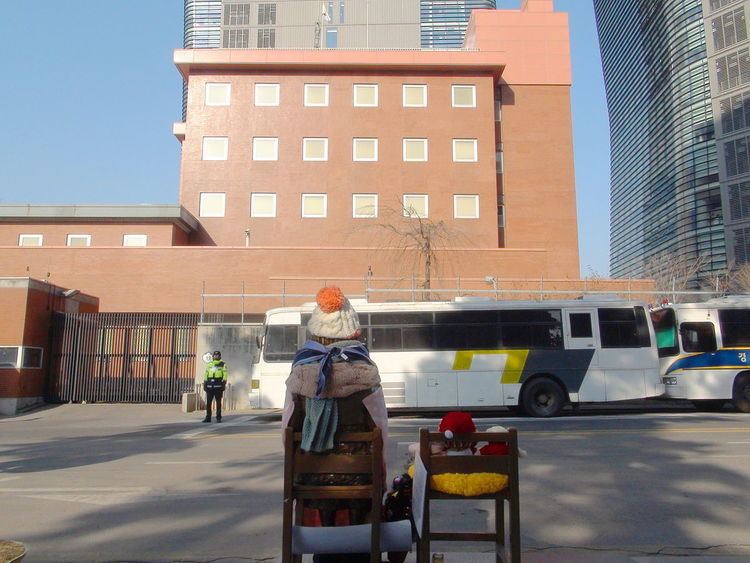Hangul 평화의 소녀상 Revised Romanization Pyeonghwaui sonyeosang Medium bronze | Hanja 平和의 少女像 慰安婦像 第五種補給品像 McCune–Reischauer P'yŏnghwaŭi sonyŏsang | |
 | ||
Completion date December 10, 2011 (2011-12-10) | ||
The Statue of Peace (Korean: 평화의 소녀상, Pyeonghwaui sonyeosang), also often called Sonyeosang (literally "Statue of Girl") in Korean pronunciation or Statue of Comfort Woman (慰安婦像, Ianfu-zō) in Japan, is a symbol of the victims of sexual slavery, known as comfort women, by the Japanese imperial military during World War II. The Statue of Peace was erected to call for apology and remembrance.
Contents
History
The Wednesday demonstration started in 1992 and, nearly 20 years later, the idea for the Statue of Peace was proposed by the Korean Council for Women Drafted for Military Sexual Slavery by Japan. More specifically, the council proposed that a memorial stone be erected in front of the Embassy of Japan in Korea to commemorate the pain of comfort women as the victims of sexual slavery by the Japanese imperial military. This proposal was realized on 14 December 2011, when the bronze statue was installed in front of the embassy. Yeongjong Kim, who was head of Jongno-gu, provided design ideas and works of art in the form of a girl instead of a memorial stone. The Statue of Peace was built by the couple Unseong Kim and Seogyeong Kim. The statue depicts a girl dressed in a chima jeogori (a modified form of hanbok in the late 19th-early 20th century), with small hands and short hair, sitting and staring at the Embassy of Japan in central Seoul.
Japan has repeatedly demanded that the statue be removed, but Seoul and especially the victims have rejected such demands consistently as the Japanese government has never officially admitted its direct involvement of the military with regards to comfort women issue.
Other statues inspired by the Statue of Peace
The issue of comfort women and the Statue of Peace has inspired other such statues to be built in Seoul and in cities around the world with sizable Korean populations.
In May 2012, officials in the borough of Palisades Park in Bergen County, New Jersey rejected requests by two diplomatic delegations from Japan to remove a small monument from a public park, a brass plaque on a block of stone, dedicated in 2010 to the memory of so-called comfort women, tens of thousands of women and girls, many Korean, who were forced into sexual slavery by Japanese soldiers during World War II. Days later, a South Korean delegation endorsed the borough's decision. However, in neighboring Fort Lee, New Jersey, various Korean American groups could not reach consensus on the design and wording for such a monument as of early April 2013. In October 2012, a similar memorial was announced in nearby Hackensack, New Jersey, to be raised behind the Bergen County Courthouse, alongside memorials to the Holocaust, the Irish Potato Famine, and the Armenian Genocide, and was unveiled in March 2013. An apology and monetary compensation of roughly US$8 million by Japan to South Korea in December 2015 for these transgressions largely fell flat in Bergen County, where the first U.S. monument to pay respects to comfort women was erected.
